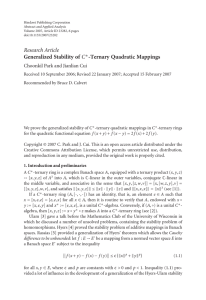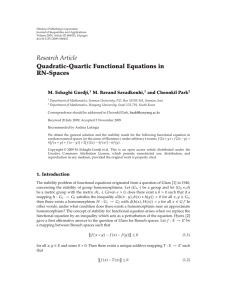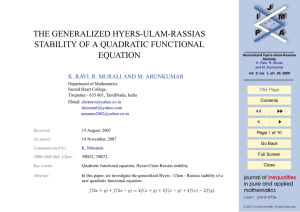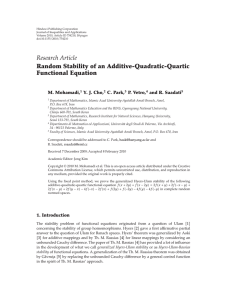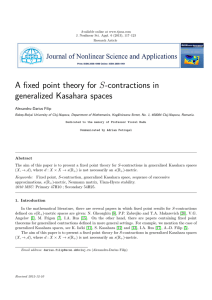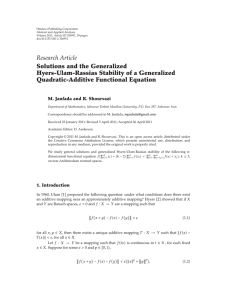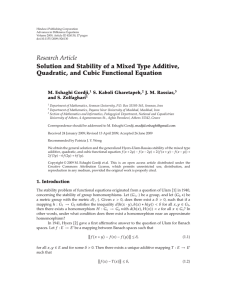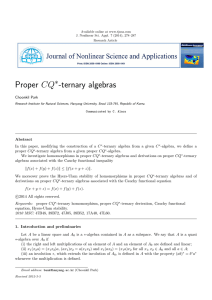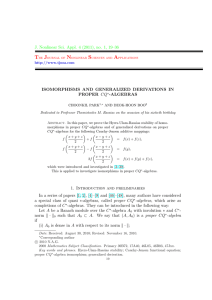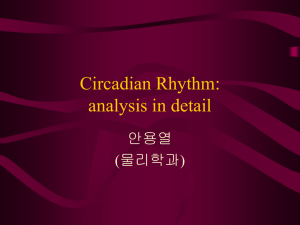T J N S
advertisement
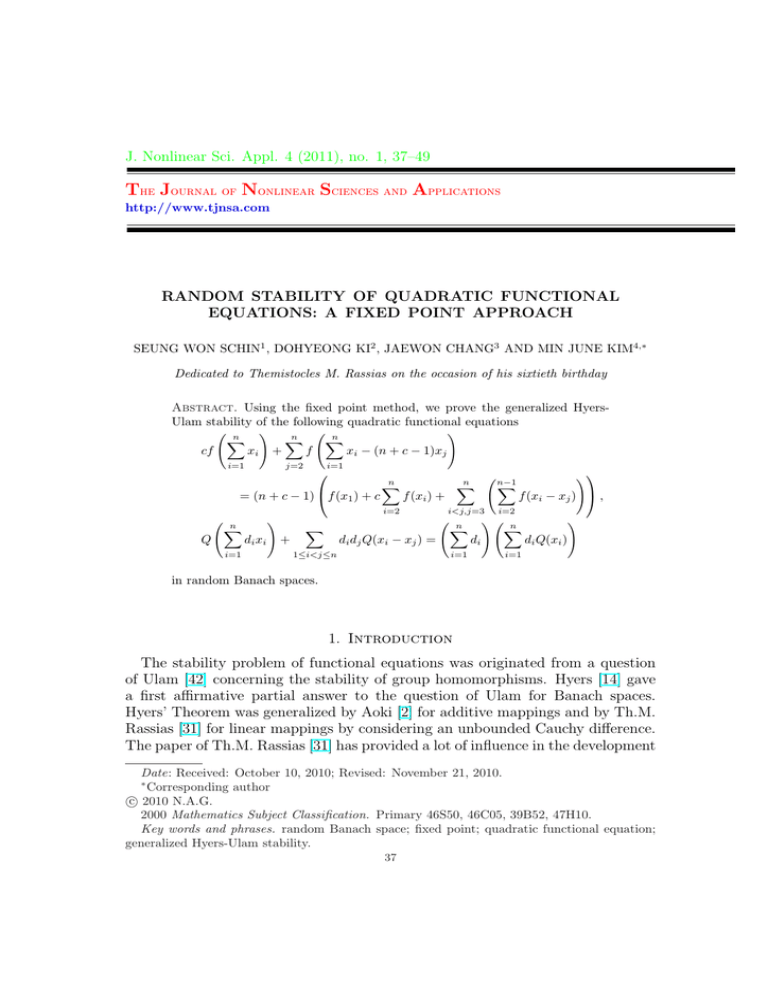
J. Nonlinear Sci. Appl. 4 (2011), no. 1, 37–49
The Journal of Nonlinear Sciences and Applications
http://www.tjnsa.com
RANDOM STABILITY OF QUADRATIC FUNCTIONAL
EQUATIONS: A FIXED POINT APPROACH
SEUNG WON SCHIN1 , DOHYEONG KI2 , JAEWON CHANG3 AND MIN JUNE KIM4,∗
Dedicated to Themistocles M. Rassias on the occasion of his sixtieth birthday
Abstract. Using the fixed point method, we prove the generalized HyersUlam stability of the following quadratic functional equations
à n
!
à n
!
n
X
X
X
xi +
f
xi − (n + c − 1)xj
cf
i=1
j=2
i=1
= (n + c − 1) f (x1 ) + c
Q
à n
X
i=1
+
X
di dj Q(xi − xj ) =
i<j,j=3
Ã
n
X
i=1
1≤i<j≤n
Ãn−1
X
n
X
f (xi ) +
i=2
!
di xi
n
X
di
!
f (xi − xj ) ,
i=2
!Ã n
X
!
di Q(xi )
i=1
in random Banach spaces.
1. Introduction
The stability problem of functional equations was originated from a question
of Ulam [42] concerning the stability of group homomorphisms. Hyers [14] gave
a first affirmative partial answer to the question of Ulam for Banach spaces.
Hyers’ Theorem was generalized by Aoki [2] for additive mappings and by Th.M.
Rassias [31] for linear mappings by considering an unbounded Cauchy difference.
The paper of Th.M. Rassias [31] has provided a lot of influence in the development
Date: Received: October 10, 2010; Revised: November 21, 2010.
∗
Corresponding author
c 2010 N.A.G.
°
2000 Mathematics Subject Classification. Primary 46S50, 46C05, 39B52, 47H10.
Key words and phrases. random Banach space; fixed point; quadratic functional equation;
generalized Hyers-Ulam stability.
37
38
D. KI, S. SCHIN, J. CHANG, M. KIM
of what we call generalized Hyers-Ulam stability or Hyers-Ulam-Rassias stability
of functional equations. A generalization of the Th.M. Rassias theorem was
obtained by Găvruta [10] by replacing the unbounded Cauchy difference by a
general control function in the spirit of the Th.M. Rassias’ approach.
The functional equation
f (x + y) + f (x − y) = 2f (x) + 2f (y)
is called a quadratic functional equation. In particular, every solution of the
quadratic functional equation is said to be a quadratic mapping. The generalized
Hyers-Ulam stability of the quadratic functional equation was proved by Skof
[41] for mappings f : X → Y , where X is a normed space and Y is a Banach
space. Cholewa [6] noticed that the theorem of Skof is still true if the relevant
domain X is replaced by an Abelian group. Czerwik [7] proved the generalized
Hyers-Ulam stability of the quadratic functional equation. The stability problems
of several functional equations have been extensively investigated by a number
of authors and there are many interesting results concerning this problem (see
[1, 8, 11, 15, 17], [32]–[38]).
2. Preliminaries
We define the notion of a random normed space, which goes back to Sherstnev
(see, e.g., [12, 40]).
In the sequel, we adopt the usual terminology, notations and conventions of
the theory of random normed spaces, as in. Throughout this paper, let ∆+ is the
space of distribution functions, that is,
∆+ : = {F : R ∪{−∞, ∞} → [0, 1] : F is lef t − continuous,
non − decreasing on R, F (0) = 0 and F (+∞) = 1}
and the subset D+ ⊆ ∆+ is the set D+ = {F ∈ ∆+ : l− F (+∞) = 1}, where
l− f (x) denotes the left limit of the function f at the point x. The space ∆+ is
partially ordered by the usual point-wise ordering of functions, i.e., F ≤ G if and
only if F (t) ≤ G(t) for all t ∈ R. The maximal element for ∆+ in this order is
the distribution function given by
(
0, if t ≤ 0,
ε0 (t) =
1, if t > 0.
Definition 2.1. ([39]) A function T : [0, 1] × [0, 1] → [0, 1] is a continuous
triangular norm (briefly, a t−norm) if T satisfies the following conditions:
(T N1 ) T is commutative and associative;
(T N2 ) T is continuous;
(T N3 ) T (a, 1) = a for all a ∈ [0, 1];
(T N4 ) T (a, b) ≤ T (c, d) whenever a ≤ c and b ≤ d for all a, b, c, d ∈ [0, 1].
Typical examples of continuous t−norms are TP (a, b) = ab, TM (a, b) = min(a, b)
and TL (a, b) = max(a + b − 1, 0) (the L
à ukasiewicz t-norm). Recall (see [12, 13])
RANDOM STABILITY OF FUNCTIONAL EQUATIONS
39
n
that if T is a t−norm and {xn } is a given sequence of numbers in [0, 1], Ti=1
xi is
defined recurrently by
(
x1 ,
if n = 1,
n
Ti=1
xi =
n−1
T (Ti=1 xi , xn ), if n ≥ 2.
∞
∞
Ti=n
xi is defined as Ti=1
xn+i .
Definition 2.2. ([40]) A random normed space (briefly, RN -space) is a triple
(X, Λ, T ), where X is a vector space, T is a continuous t−norm, and Λ is a
mapping from X into D+ such that the following conditions hold:
(RN1 ) Λx (t) = ε0 (t) for all t > 0 if and only if x = 0;
t
(RN2 ) Λαx (t) = Λx ( |α|
) for all x ∈ X, α 6= 0;
(RN3 ) Λx+y (t + s) ≥ T (Λx (t), Λy (s)) for all x, y ∈ X and all t, s ≥ 0.
Every normed space (X, k . k) defines a random normed space (X, Λ, TM ), where
t
Λu (t) = t+kuk
for all t > 0 and TM is the minimum t−norm. This space is called
the induced random normed space.
Definition 2.3. Let (X, Λ, T ) be an RN -space.
(1) A sequence {xn } in X is said to be convergent to x in X if, for every ² > 0
and λ > 0, there exists a positive integer N such that Λxn −x (²) > 1 − λ whenever
n ≥ N.
(2) A sequence {xn } in X is called Cauchy if, for every ² > 0 and λ > 0, there
exists a positive integer N such that Λxn −xm (²) > 1 − λ whenever n ≥ m ≥ N .
(3) An RN -space (X, Λ, T ) is said to be complete if every Cauchy sequence in
X is convergent to a point in X. A complete RN -space is said to be a random
Banach space.
Theorem 2.4. ([39]) If (X, Λ, T ) is an RN -space and {xn } is a sequence such
that xn → x, then limn→∞ Λxn (t) = Λx (t) almost everywhere.
Starting with the paper [23], the stability of some functional equations in the
framework of fuzzy normed spaces or random normed spaces has been investigated
in [18]–[26].
Let X be a set. A function d : X × X → [0, ∞] is called a generalized metric
on X if d satisfies
(1) d(x, y) = 0 if and only if x = y;
(2) d(x, y) = d(y, x) for all x, y ∈ X;
(3) d(x, z) ≤ d(x, y) + d(y, z) for all x, y, z ∈ X.
Let (X, d) be a generalized metric space. An operator T : X → X satisfies
a Lipschitz condition with Lipschitz constant L if there exists a constant L ≥ 0
such that d(T x, T y) ≤ Ld(x, y) for all x, y ∈ X. If the Lipschitz constant L is less
than 1, then the operator T is called a strictly contractive operator. Note that
the distinction between the generalized metric and the usual metric is that the
range of the former is permitted to include the infinity. We recall the following
theorem by Margolis and Diaz.
Theorem 2.5. [3, 9] Let (X, d) be a complete generalized metric space and let
J : X → X be a strictly contractive mapping with Lipschitz constant L < 1. Then
40
D. KI, S. SCHIN, J. CHANG, M. KIM
for each given element x ∈ X, either
d(J n x, J n+1 x) = ∞
for all nonnegative integers n or there exists a positive integer n0 such that
(1) d(J n x, J n+1 x) < ∞,
∀n ≥ n0 ;
(2) the sequence {J n x} converges to a fixed point y ∗ of J;
(3) y ∗ is the unique fixed point of J in the set Y = {y ∈ X | d(J n0 x, y) < ∞};
1
(4) d(y, y ∗ ) ≤ 1−L
d(y, Jy) for all y ∈ Y .
In 1996, G. Isac and Th.M. Rassias [16] were the first to provide applications of
stability theory of functional equations for the proof of new fixed point theorems
with applications. By using fixed point methods, the stability problems of several
functional equations have been extensively investigated by a number of authors
(see [4, 5], [27]–[29], [30]).
This paper is organized as follows: In Section 3, we prove the generalized
Hyers-Ulam stability of the quadratic functional equation
à n
!
à n
!
n
X
X
X
cf
xi +
(2.1)
f
xi − (n + c − 1)xj
i=1
j=2
Ã
i=1
= (n + c − 1) f (x1 ) + c
n
X
n
X
f (xi ) +
i=2
i<j,j=3
à n−1
X
!!
f (xi − xj )
i=2
in random Banach spaces by using the fixed point method. In Section 4, we prove
the generalized Hyers-Ulam stability of the quadratic functional equation
à n
!
à n !à n
!
X
X
X
X
Q
di xi +
di dj Q(xi − xj ) =
di
di Q(xi )
(2.2)
i=1
i=1
1≤i<j≤n
i=1
in random Banach spaces.
Throughout this paper, assume that X is a vector spaces and (Y, µ, T ) is a
complete RN -space.
3. Generalized Hyers-Ulam stability of the quadratic functional
equation (2.1) in RN-spaces
For a given mapping f : X → Y , consider the mapping P f : X n → Y , defined
by
à n
!
à n
!
n
X
X
X
P f (x1 , x2 , · · · , xn ) = cf
f
xi +
xi − (n + c − 1)xj
Ã
j=2
i=1
−(n + c − 1) f (x1 ) + c
n
X
i=2
f (xi ) +
i=1
n
X
i<j,j=3
à n−1
X
!!
f (xi − xj )
i=2
for all x1 , · · · , xn ∈ X.
Using the fixed point method, we prove the generalized Hyers-Ulam stability
of the quadratic functional equation P f (x1 , · · · , xn ) = 0 in complete RN-spaces.
RANDOM STABILITY OF FUNCTIONAL EQUATIONS
41
Theorem 3.1. Let v := 2 − n − c > 1. Let ρ : X n → D+ be a mapping
(ρ(x1 , · · · , xn ) is denoted by ρx1 ,··· ,xn ) such that, for some 0 < α < v 2 ,
ρvx1 ,··· ,vxn (αt) ≥ ρx1 ,··· ,xn (t)
(3.1)
for all x1 , · · · , xn ∈ X and all t > 0. Suppose that an even mapping f : X → Y
with f (0) = 0 satisfies the inequality
µP f (x1 ,··· ,xn ) (t) ≥ ρx1 ,··· ,xn (t)
(3.2)
for all x1 , · · · xn ∈ X and all t > 0. Then there exists a unique quadratic mapping
Q : X → Y such that
¡
¢
µf (x)−Q(x) (t) ≥ ρ0,x,0,··· ,0 (v 2 − α)t
for all x ∈ X and all t > 0.
Proof. Putting x2 = x and x1 = x3 = x4 = · · · = xn = 0 in (3.2), we get
µf ((2−c−n)x)−(2−c−n)2 f (x) (t) ≥ ρ0,x,0,··· ,0 (t)
(3.3)
for all x ∈ X and all t > 0. Replacing 2 − c − n by v in (3.3), we get
µf (vx)−v2 f (x) (t) ≥ ρ0,x,0,··· ,0 (t)
(3.4)
for all x ∈ X and all t > 0. Therefore,
µ f (vx) −f (x) (t) ≥ ρ0,x,0,··· ,0 (v 2 t)
v2
(3.5)
for all x ∈ X and all t > 0.
Let S be the set of all even mappings h : X → Y with h(0) = 0 and introduce
a generalized metric on S as follows:
n
o
d(h, k) = inf u ∈ R+ : µh(x)−k(x) (ut) ≥ ρ0,x,0,··· ,0 (t), ∀x ∈ X, ∀t > 0 ,
where, as usual, inf ∅ = +∞. It is easy to show that (S, d) is a generalized
complete metric space (see [19, Lemma 2.1]).
Now we define the mapping J : S → S
h (vx)
Jh(x) :=
v2
for all h ∈ S and x ∈ X. Let f, g ∈ S such that d(f, g) < ε. Therefore
³ αu ´
³ αu ´
µJg(x)−Jf (x)
t
=
µ
t = µg(vx)−f (vx) (αut)
g(vx)
f (vx)
− 2
v2
v2
v2
v
≥ ρ0,vx,0,··· ,0 (αt) ≥ ρ0,x,0,··· ,0 (t),
that is, if d(f, g) < ε we have d(Jf, Jg) <
α
ε.
v2
Hence
α
d(f, g)
v2
for all f, g ∈ S, that is, J is a strictly contractive self-mapping on S with the
Lipschitz constant α/v 2 (< 1).
It follows from (3.5) that
µ ¶
1
µJf (x)−f (x)
t ≥ ρ0,x,0,··· ,0 (t)
v2
d(Jf, Jg) ≤
42
D. KI, S. SCHIN, J. CHANG, M. KIM
for all x ∈ X and all t > 0, which means that d(Jf, f ) ≤ v12 .
By Theorem 2.5, there exists a unique mapping Q : X → Y such that Q is a
fixed point of J, i.e., Q (2x) = 4Q(x) for all x ∈ X.
Also, d(J m g, Q) → 0 as m → ∞, which implies the equality
f (v m x)
= Q(x)
m→∞
v 2m
lim
for all x ∈ X.
It follows from (3.1) and (3.2) that
¡
µ P f (vm x1 ,··· ,vm xn ) (t) ≥ ρvm x1 ,··· ,vm xn v
v 2m
2m
t
¢
µ
µ
v2
m
m
= ρv x1 ,··· ,v xn α
α
µµ 2 ¶m ¶
v
≥ ρx1 ,··· ,xn
t
α
m
¶m ¶
t
(3.6)
for all x1 , · · · , xn ∈ X and all t > 0. Letting m → ∞ in (3.6), we find that
µP Q(x1 ,··· ,xn ) (t) = 1 for all t > 0, which implies P Q(x1 , · · · , xn ) = 0. Therefore,
the mapping Q : X → Y is quadratic.
Since Q is the unique fixed point of J in the set Ω = {g ∈ S : d(f, g) < ∞}, Q
is the unique mapping such that
µf (x)−Q(x) (ut) ≥ ρ0,x,0,··· ,0 (t)
for all x ∈ X and all t > 0. Using the fixed point alternative, we obtain that
d(f, Q) ≤
1
1
1
d(f, Jf ) ≤ 2
= 2¡
1−L
v (1 − L)
v 1−
which implies the inequality
µf (x)−Q(x)
µ
α
v2
¢,
¶
1
t ≥ ρ0,x,0,··· ,0 (t)
v2 − α
for all x ∈ X and all t > 0. So
¡
¢
µf (x)−Q(x) (t) ≥ ρ0,x,0,··· ,0 (v 2 − α)t
for all x ∈ X and all t > 0.
¤
Theorem 3.2. Let ρ : X n → D+ be a mapping (ρ(x1 , · · · , xn ) is denoted by
ρx1 ,··· ,xn ) such that, for some α > v 2 ,
ρ xv1 ,··· , xvn (t) ≥ ρx1 ,··· ,xn (αt)
(3.7)
for all x1 , · · · , xn ∈ X and all t > 0. Suppose that an even mapping f : X → Y
satisfying f (0) = 0 and (3.2). Then there exists a unique quadratic mapping
Q : X → Y such that
¡
¢
µf (x)−Q(x) (t) ≥ ρ0,x,0,··· ,0 (α − v 2 )t
for all x ∈ X and all t > 0.
RANDOM STABILITY OF FUNCTIONAL EQUATIONS
43
Proof. Let (S, d) be the generalized metric space defined in the proof of Theorem
3.1.
Now we consider the mapping J : S → S defined by
³x´
2
Jh(x) := v h
v
for all h ∈ S and x ∈ X. Let f, g ∈ S such that d(f, g) < ε. Then
µ 2 ¶
µ 2 ¶
³u ´
v u
v u
µJg(x)−Jf (x)
t
= µv2 g( x )−v2 f ( x )
t = µg( x )−f ( x )
t
v
v
v
v
α
α
α
µ ¶
t
≥ ρ0,x,0,··· ,0 (t),
≥ ρ0, xv ,0,··· ,0
(3.8)
α
that is, if d(f, g) < ε we have d(Jf, Jg) <
v2
ε.
α
This means that
v2
d(f, g)
α
for all f, g ∈ S, that is, J is a strictly contractive self-mapping on S with the
2
Lipschitz constant vα (< 1).
By Theorem 2.5, there
¡ ¢exists a unique mapping Q : X → Y such that Q is a
fixed point of J, i.e., Q xv = v12 Q(x) for all x ∈ X.
Also, d(J m g, Q) → 0 as m → ∞, which implies the equality
³ x ´
lim v 2 mf m = Q(x)
m→∞
v
for all x ∈ X.
It follows from (3.7) that
µ ¶
1
t
µJf (x)−f (x)
t ≥ ρ0, xv ,0,··· ,0 ( ) ≥ ρ0,x,0,··· ,0 (t)
α
α
d(Jf, Jg) ≤
for all x ∈ X and all t > 0, which implies that d(Jf, f ) ≤ α1 .
Since Q is the unique fixed point of J in the set Ω = {g ∈ S : d(f, g) < ∞}, Q
is the unique mapping such that
µf (x)−Q(x) (ut) ≥ ρ0,x,0,··· ,0 (t)
for all x ∈ X and all t > 0. Using the fixed point alternative, we obtain that
1
1
1
d(f, Q) ≤
d(f, Jf ) ≤
= ¡
2 ¢,
1−L
α(1 − L)
α 1 − vα
which implies the inequality
µ
µf (x)−Q(x)
¶
1
t ≥ ρ0,x,0,··· ,0 (t)
(α − v 2 )
for all x ∈ X and all t > 0. So
¡
¢
µf (x)−Q(x) (t) ≥ ρ0,x,0,··· ,0 (α − v 2 )t
for all x ∈ X and all t > 0.
The rest of the proof is similar to the proof of Theorem 3.1.
¤
44
D. KI, S. SCHIN, J. CHANG, M. KIM
4. Generalized Hyers-Ulam stability of the quadratic functional
equation (2.2) in RN-spaces
For a given mapping Q : X → Y , we define
à n
!
à n
!
n
X
X
X
X
DQ(x1 , · · · , xn ) := Q
di xi +
di dj Q (xi − xj ) −
di
di Q (xi )
i=1
i=1
1≤i<j≤n
i=1
for all x1 , · · · , xn ∈ X.
Using the fixed point method, we prove the generalized Hyers-Ulam stability
of the functional equation DQ(x1 , · · · , xn ) = 0 in random Banach spaces
P
Theorem 4.1. Let d := ni=1 di . Let ρ : X n → D+ be a mapping (ρ(x1 , · · · , xn )
is denoted by ρx1 ,··· ,xn ) such that, for some 0 < α < d2 ,
ρdx1 ,··· ,dxn (αt) ≥ ρx1 ,··· ,xn (t)
(4.1)
for all x1 , · · · , xd ∈ X and all t > 0. Suppose that an even mapping f : X → Y
with f (0) = 0 satisfies the inequality
µDQ(x1 ,··· ,xn ) (t) ≥ ρx1 ,··· ,xn (t)
(4.2)
for all x1 , · · · x2l ∈ X and all t > 0. Then there exists a unique quadratic mapping
R : X → Y such that
¡
¢
µQ(x)−R(x) (t) ≥ ρx, · · · , x (d2 − α)t
| {z }
n times
for all x ∈ X and all t > 0.
Proof. Putting x1 = · · · = xn = x in (4.2), we get
µQ(dx)−d2 Q(x) (t) ≥ ρx, · · · , x (t)
| {z }
(4.3)
n times
for all x ∈ X and all t > 0. It follows from (4.3) that
µ Q(dx) −Q(x) (t) ≥ ρx, · · · , x (d2 t)
d2
| {z }
(4.4)
n times
for all x ∈ X and all t > 0.
Let S be the set of all even mappings h : X → Y with h(0) = 0 and introduce
a generalized metric on S as follows:
n
o
+
d(h, k) = inf u ∈ R : µh(x)−k(x) (ut) ≥ ρx, · · · , x (t), ∀x ∈ X, ∀t > 0 ,
| {z }
n times
where, as usual, inf ∅ = +∞. It is easy to show that (S, d) is a generalized
complete metric space (see [19, Lemma 2.1]).
Now we consider the mapping J : S → S defined by
Jh(x) :=
h (dx)
d2
RANDOM STABILITY OF FUNCTIONAL EQUATIONS
for all h ∈ S and x ∈ X. Let f, g
³ αu ´
t =
µJg(x)−Jf (x)
d2
≥
45
∈ S such that d(f, g) < ε. Then
³ αu ´
µ g(dx) − f (dx)
t = µg(dx)−f (dx) (αut)
d2
d2
d2
ρdx, · · · , dx (αt) ≥ ρx, · · · , x (t),
| {z }
| {z }
n times
n times
that is, if d(f, g) < ε we have d(Jf, Jg) <
α
ε.
d2
This means that
α
d(f, g)
d2
for all f, g ∈ S, that is, J is a strictly contractive self-mapping on S with the
Lipschitz constant dα2 .
It follows from (4.4) that
µ ¶
1
µJQ(x)−Q(x)
t ≥ ρx, · · · , x (t)
d2
| {z }
d(Jf, Jg) ≤
n times
for all x ∈ X and all t > 0, which implies that d(JQ, Q) ≤ d12 .
By Theorem 2.5, there exists a unique mapping R : X → Y such that R is a
fixed point of J, i.e., R (dx) = d2 R(x) for all x ∈ X.
Also, d(J m g, Q) → 0 as m → ∞, which implies the equality
Q (dm x)
= R(x)
m→∞
d2m
lim
for all x ∈ X.
It follows from (4.1) and (4.2) that
¡
2m
µ DQ(dm x1 ,··· ,dm xn ) (t) ≥ ρdm x1 ,··· ,dm xn d
d2m
t
¢
µµ
= ρx1 ,··· ,xn
d2
α
¶m ¶
t
(4.5)
for all x1 , · · · , xn ∈ X and all t > 0. Letting m → ∞ in (4.5), we find that
µDR(x1 ,··· ,xn ) (t) = 1 for all t > 0, which implies DR(x1 , · · · , xn ) = 0. Since Q is
even, R is even. So the mapping R : X → Y is quadratic.
Since R is the unique fixed point of J in the set Ω = {g ∈ S : d(f, g) < ∞}, R
is the unique mapping such that
µQ(x)−R(x) (ut) ≥ ρx, · · · , x (t)
| {z }
n times
for all x ∈ X and all t > 0. Using the fixed point alternative, we obtain that
1
1
1
1
¢= 2
d(Q, JQ) ≤ 2
= 2¡
,
d(Q, R) ≤
α
1−L
d (1 − L)
d −α
d 1 − d2
which implies the inequality
µ
µQ(x)−R(x)
1
t
d2 − α
¶
≥ ρx, · · · , x (t)
| {z }
n times
for all x ∈ X and all t > 0. So
¡
¢
µQ(x)−R(x) (t) ≥ ρx, · · · , x (d2 − α)t
| {z }
n times
46
D. KI, S. SCHIN, J. CHANG, M. KIM
for all x ∈ X and all t > 0.
¤
Theorem 4.2. Let ρ : X n → D+ be a mapping (ρ(x1 , · · · , xn ) is denoted by
ρx1 ,··· ,xn ) such that, for some α > d2 ,
ρ xd1 ,··· , xdn (t) ≥ ρx1 ,··· ,xn (αt)
(4.6)
for all x1 , · · · , xn ∈ X and all t > 0. Suppose that an even mapping Q : X → Y
satisfying Q(0) = 0 and (4.2). Then there exists a unique quadratic mapping
R : X → Y such that
¡
¢
µR(x)−Q(x) (t) ≥ ρx, · · · , x (α − d2 )t
| {z }
n times
for all x ∈ X and all t > 0.
Proof. Let (S, d) be the generalized metric space defined in the proof of Theorem
4.1.
Now we consider the mapping J : S → S defined by
³x´
2
Jh(x) := d h
d
for all h ∈ S and x ∈ X. Let f, g ∈ S such that d(f, g) < ε. Then
µ 2 ¶
µ 2 ¶
³ε ´
dε
dε
µJg(x)−Jf (x)
t
= µd2 g( x )−d2 f ( x )
t = µg( x )−f ( x )
t
d
d
d
d
α
α
α
µ ¶
t
≥ ρx, · · · , x (t),
≥ ρx
x
α
| {z }
,··· ,
n times
|d {z d}
n times
that is, if d(f, g) < ε we have d(Jf, Jg) <
d2
ε.
α
This means that
d2
d(f, g)
α
for all f, g ∈ S, that is, J is a strictly contractive self-mapping on S with the
2
Lipschitz constant dα .
By Theorem 2.5, there
¡ ¢exists a unique mapping R : X → Y such that R is a
fixed point of J, i.e., R xd = d12 R(x) for all x ∈ X.
Also, d(J m g, R) → 0 as m → ∞, which implies the equality
³ x ´
lim d2m Q m = R(x)
m→∞
d
for all x ∈ X.
It follows from (4.3) that
µ ¶
1
t ≥ ρx, · · · , x (t)
µJQ(x)−Q(x)
α
| {z }
d(Jf, Jg) ≤
n times
for all x ∈ X and all t > 0, which implies that d(JQ, Q) ≤ α1 .
RANDOM STABILITY OF FUNCTIONAL EQUATIONS
47
Since R is the unique fixed point of J in the set Ω = {g ∈ S : d(f, g) < ∞}, R
is the unique mapping such that
µQ(x)−R(x) (ut) ≥ ρx, · · · , x (t)
| {z }
n times
for all x ∈ X and all t > 0. Using the fixed point alternative, we obtain that
1
1
1
1
¢
d(Q, R) ≤
d(Q, JQ) ≤
= ¡
=
,
2
1−L
α(1 − L)
α − d2
α 1 − dα
which implies the inequality
µ
µQ(x)−R(x)
1
t
α − d2
¶
≥ ρx, · · · , x (t)
| {z }
n times
for all x ∈ X and all t > 0. So
¡
¢
µQ(x)−R(x) (t) ≥ ρx, · · · , x (α − d2 )t
| {z }
n times
for all x ∈ X and all t > 0.
The rest of the proof is similar to the proof of Theorem 4.1.
¤
Acknowledgement
This work was supported by the R&E program in 2010.
References
[1] J. Aczel and J. Dhombres, Functional Equations in Several Variables, Cambridge University Press, Cambridge, 1989.
[2] T. Aoki, On the stability of the linear transformation in Banach spaces, J. Math. Soc.
Japan, 2 (1950), 64–66.
[3] L. Cădariu and V. Radu, Fixed points and the stability of Jensen’s functional equation,
J. Inequal. Pure Appl. Math., 4, no. 1, Art. ID 4 (2003).
[4] L. Cădariu and V. Radu, On the stability of the Cauchy functional equation: a fixed point
approach, Grazer Math. Ber., 346 (2004), 43–52.
[5] L. Cădariu and V. Radu, Fixed point methods for the generalized stability of functional
equations in a single variable, Fixed Point Theory and Applications, 2008, Art. ID 749392
(2008).
[6] P.W. Cholewa, Remarks on the stability of functional equations, Aequationes Math., 27
(1984), 76–86.
[7] S. Czerwik, On the stability of the quadratic mapping in normed spaces, Abh. Math. Sem.
Univ. Hamburg, 62 (1992), 59–64.
[8] P. Czerwik, Functional Equations and Inequalities in Several Variables, World Scientific
Publishing Company, New Jersey, Hong Kong, Singapore and London, 2002.
[9] J. Diaz and B. Margolis, A fixed point theorem of the alternative for contractions on a
generalized complete metric space, Bull. Amer. Math. Soc., 74 (1968), 305–309.
[10] P. Găvruta, A generalization of the Hyers-Ulam-Rassias stability of approximately additive
mappings, J. Math. Anal. Appl., 184 (1994), 431–436.
[11] M.E. Gordji, M.B. Ghaemi and H. Hajani, Generalized Hyers-Ulam-Rassias theorem in
Menger probabilistic normed spaces, Discrete Dynamics in Nature and Society, 2010, Art.
ID 162371 (2010).
[12] O. Hadžić and E. Pap, Fixed Point Theory in PM Spaces, Kluwer Academic Publishers,
Dordrecht, 2001.
48
D. KI, S. SCHIN, J. CHANG, M. KIM
[13] O. Hadžić, E. Pap and M. Budincević, Countable extension of triangular norms and their
applications to the fixed point theory in probabilistic metric spaces, Kybernetica, 38
(2002), 363–381.
[14] D.H. Hyers, On the stability of the linear functional equation, Proc. Nat. Acad. Sci.
U.S.A., 27 (1941), 222–224.
[15] D.H. Hyers, G. Isac and Th.M. Rassias, Stability of Functional Equations in Several Variables, Birkhäuser, Basel, 1998.
[16] G. Isac and Th.M. Rassias, Stability of ψ-additive mappings: Appications to nonlinear
analysis, Internat. J. Math. Math. Sci., 19 (1996), 219–228.
[17] S. Jung, Hyers-Ulam-Rassias Stability of Functional Equations in Mathematical Analysis,
Hadronic Press lnc., Palm Harbor, Florida, 2001.
[18] D. Miheţ, The fixed point method for fuzzy stability of the Jensen functional equation,
Fuzzy Sets and Systems, 160 (2009), 1663–1667.
[19] D. Miheţ and V. Radu, On the stability of the additive Cauchy functional equation in
random normed spaces, J. Math. Anal. Appl., 343 (2008), 567–572.
[20] D. Miheţ, R. Saadati and S.M. Vaezpour, The stability of the quartic functional equation
in random normed spaces, Acta Appl. Math., 110 (2010), 797–803.
[21] D. Miheţ, R. Saadati and S.M. Vaezpour, The stability of an additive functional equation
in Menger probabilistic ϕ-normed spaces, Math. Slovak, (in press).
[22] A.K. Mirmostafaee, A fixed point approach to almost quartic mappings in quasi fuzzy
normed spaces, Fuzzy Sets and Systems, 160 (2009), 1653–1662.
[23] A.K. Mirmostafaee, M. Mirzavaziri and M.S. Moslehian, Fuzzy stability of the Jensen
functional equation, Fuzzy Sets and Systems, 159 (2008), 730–738.
[24] A.K. Mirmostafaee and M.S. Moslehian, Fuzzy versions of Hyers-Ulam-Rassias theorem,
Fuzzy Sets and Systems, 159 (2008), 720–729.
[25] A.K. Mirmostafaee and M.S. Moslehian, Fuzzy approximately cubic mappings, Inform.
Sci., 178 (2008), 3791–3798.
[26] A.K. Mirmostafaee and M.S. Moslehian, Fuzzy stability of additive mappings in nonArchimedean fuzzy normed spaces, Fuzzy Sets and Systems, 160 (2009), 1643–1652.
[27] M. Mirzavaziri and M.S. Moslehian, A fixed point approach to stability of a quadratic
equation, Bull. Braz. Math. Soc., 37 (2006), 361–376.
[28] C. Park, Fixed points and Hyers-Ulam-Rassias stability of Cauchy-Jensen functional equations in Banach algebras, Fixed Point Theory and Applications, 2007, Art. ID 50175 (2007).
[29] C. Park, Generalized Hyers-Ulam-Rassias stability of quadratic functional equations: a
fixed point approach, Fixed Point Theory and Applications 2008, Art. ID 493751 (2008).
[30] V. Radu, The fixed point alternative and the stability of functional equations, Fixed Point
Theory, 4 (2003), 91–96.
[31] Th.M. Rassias, On the stability of the linear mapping in Banach spaces, Proc. Amer.
Math. Soc., 72 (1978), 297–300.
[32] Th.M. Rassias, Problem 16; 2, Report of the 27th International Symp. on Functional
Equations, Aequationes Math., 39 (1990), 292–293.
[33] Th.M. Rassias, On the stability of the quadratic functional equation and its applications,
Studia Univ. Babes-Bolyai, XLIII (1998), 89–124.
[34] Th.M. Rassias, The problem of S.M. Ulam for approximately multiplicative mappings, J.
Math. Anal. Appl., 246 (2000), 352–378.
[35] Th.M. Rassias, On the stability of functional equations and a problem of Ulam, Acta
Appl. Math., 62 (2000), 23–130.
[36] Th.M. Rassias and P. Šemrl, On the behaviour of mappings which do not satisfy HyersUlam stability, Proc. Amer. Math. Soc., 114 (1992), 989–993.
[37] Th.M. Rassias and P. Šemrl, On the Hyers-Ulam stability of linear mappings, J. Math.
Anal. Appl., 173 (1993), 325–338.
[38] Th.M. Rassias and K. Shibata, Variational problem of some quadratic functionals in
complex analysis, J. Math. Anal. Appl., 228 (1998), 234–253.
RANDOM STABILITY OF FUNCTIONAL EQUATIONS
49
[39] B. Schweizer and A. Sklar, Probabilistic Metric Spaces, Elsevier, North Holand, New York,
1983.
[40] A.N. Šerstnev, On the notion of a random normed space, Dokl. Akad. Nauk SSSR, 149
(1963), 280–283.
[41] F. Skof, Proprietà locali e approssimazione di operatori, Rend. Sem. Mat. Fis. Milano, 53
(1983), 113–129.
[42] S. M. Ulam, A Collection of the Mathematical Problems, Interscience Publ. New York,
1960.
1,2
Seoul Science High School, Seoul 110-530, Republic of Korea
E-mail address: maplemenia@naver.com; wooki7098@naver.com
3,4
Seoul Science High School, Seoul 110-530, Republic of Korea
E-mail address: jjwjjw9595@naver.com; frigen@naver.com
